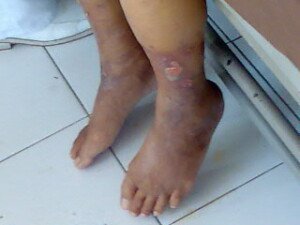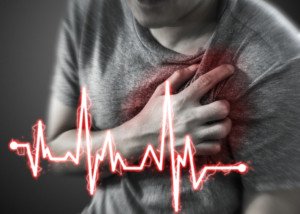
Pain in both legs that won’t respond to standard treatments or exercise may be a sign of a pending heart attack or one a few years later.
It’s quite simple to understand: The process that causes arteries to clog up in the heart can also cause arteries in the legs to clog up.
This is called peripheral artery disease (PAD) or vascular disease (PVD).
The leg pain of PAD can be an early warning of a high risk of heart attack.
“Atherosclerosis is the cause in almost all cases,” says Dr. Beatty.
“This is a patchy disease of the inner and middle layers of large and medium sized arteries.
“Fat and other substances are deposited as plaques which narrow the caliber of the blood vessel.”
The Grey Hair Comparison
You don’t get grey hairs in just one section of one side of your head; you get them evenly throughout. Same with clogged arteries.
If your heart’s arteries are blocked, why wouldn’t the arteries in both your legs have some blockages?
Let’s run that in reverse: If your legs’ arteries are blocked, why wouldn’t your heart’s arteries be too?
So if PAD/PVD causes pain in both your legs, this surely means that the arteries in your heart are clogged. Coronary blockages can lead to a heart attack.
Studies
Many studies show the connection between chronically painful legs and a heart attack.
“The worrying fact is that 20-30% of those with intermittent claudication will die from heart related problems within five years,” says Dr. Beatty.
Intermittent claudication is when “the person usually develops pain in the calf when walking. With exercise the calf muscle needs more oxygen.
“When the circulation is impaired, less blood flows to the muscles. Less blood means less oxygen.
“If a muscle isn’t getting enough oxygen it becomes painful. Typically the sufferer will rest and be able to walk again after a while.”
Prevent Lower Extremity Blockages in the Arteries

PAD/PVD
“Some of the risk factors can’t be modified,” says Dr. Beatty. “It’s more likely to occur in the elderly, in men and in those with a family history. A premature menopause also increases the risk.
“Other risk factors can be influenced or modified. Smoking and raised cholesterol (especially LDL) increase the risk.
“High blood pressure and diabetes are both risks which can be mitigated by better disease control.
“Obesity and stress are other risk factors that can be addressed.
“Drugs, such as estrogen found in the contraceptive pill, can also play a part.
“Exercise increases fibrinolytic activity and this in turn reduces the risk of atherosclerosis and blood clots.”
Other Damage from PVD
Recap of Risk Factors for PVD/PAD
• Age 50+
• Smoking
• Diabetes
• High blood pressure and cholesterol
• Overweight
• Lack of exercise
The leg pain should never stop you from walking every chance you get. Speak to your doctor about this if you’re using a handicap permit to park as close to stores as possible.
Walking, though painful, can spur the production of beneficial blood vessels around the obstruction: like a detour route for oxygenated blood that the legs desperately need.
Do NOT dismiss chronic leg soreness as just a normal part of aging or even a normal part of obesity. It could be a signal that your heart’s in trouble.

 Dr. Beatty has worked in primary medicine, surgery, accident and emergency, OBGYN, pediatrics and chronic disease management. He is the Doctor of Medicine for
Dr. Beatty has worked in primary medicine, surgery, accident and emergency, OBGYN, pediatrics and chronic disease management. He is the Doctor of Medicine for 







































